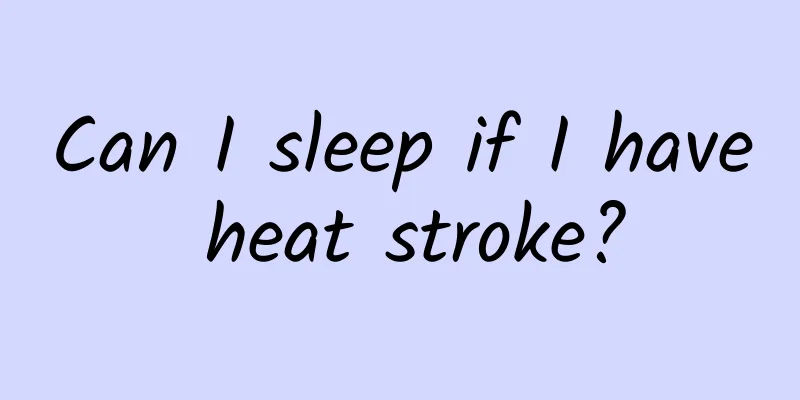Can I sleep if I have heat stroke?

|
In the hot summer, many people suffer from heat stroke due to high temperatures. As we all know, heatstroke is a relatively dangerous symptom. If the person suffering from heatstroke does not receive timely treatment and care, his life may even be in danger. Many people want to know whether they can sleep when they have heatstroke. In fact, symptoms such as dizziness and headache caused by heatstroke can make it difficult for patients to fall asleep. So, what should you do after suffering from heat stroke? The patient should be quickly moved to a cool and ventilated place to rest and drink beverages such as cool salt water to replenish the loss of salt and water. Patients with peripheral circulatory failure should be given intravenous saline, glucose solution and potassium chloride. The prognosis for patients with heat stroke is serious and the mortality rate is high. Survivors may suffer permanent brain damage, so active rescue is required. 1. External cooling Designed to rapidly reduce deep body temperature. Take off the patient's clothes, blow cool air and spray with cool water or wrap the whole body with cool wet sheets. Ice water immersion is no longer recommended because of the increased risk of complications such as hypotension and shivering. However, if other methods are unable to reduce the temperature, this method may also be considered. However, at this time, deep body temperature needs to be monitored. Once it is lower than 38.5℃, ice water cooling should be stopped to prevent hypothermia. 2. Cooling down the body If extracorporeal cooling is ineffective, gastric or rectal lavage can be performed with ice saline, peritoneal lavage or hemodialysis can be performed with sterile saline, or autologous blood can be cooled extracorporeally and then reinfused into the body for cooling. 3. Medication to reduce fever Chlorpromazine has the function of regulating the body temperature center, dilating blood vessels, relaxing muscles and reducing oxygen consumption. When patients have chills, chlorpromazine can be given intravenously while blood pressure is monitored. 4. Symptomatic treatment Comatose patients are prone to lung infection and bedsores and require intensive care; provide the necessary calories and nutrients to promote recovery, keep the airway open, and give oxygen; Actively correct water and electrolyte disorders and maintain acid-base balance; the rate of fluid replacement should not be too fast to avoid triggering heart failure. If heart failure occurs, give fast-acting digitalis preparations; use pressor drugs to correct shock; use mannitol dehydration to prevent and treat cerebral edema. Hormones have certain effects in treating pulmonary edema, cerebral edema, etc., but excessive dosage can easily lead to infection, and corresponding treatment measures should be taken for various complications. |
<<: How long does it take for a fish bone to dissolve in the throat?
>>: The harm of using Chinese medicine to stick on the navel to lose weight
Recommend
Can Eucommia ulmoides be used to make wine?
Eucommia ulmoides is a very precious Chinese medi...
What to do if your baby gets internal heat from drinking milk powder? Here are some tips to reduce internal heat in babies
When the baby reaches a certain age, the mother w...
Precautions after bloodletting
Bloodletting therapy refers to using a needle to ...
2 sentences actually cured the stubborn cervical spondylosis
Cervical spondylosis is really annoying, causing ...
What to do if you vomit? Vomiting can be relieved in this way
Vomiting is something that most people have exper...
What to do if the foreskin is broken and suppurated
When the foreskin is broken and suppuration occur...
The dangers of autologous filling of the temples cannot be ignored
Autologous filling of the temples is a relatively...
How to treat the sequelae of knee sprain? Teach you three coping methods
In life, knee sprains can easily leave sequelae i...
What's the matter with the sticky feeling in the mouth?
Humans not only communicate through their mouths,...
What medicine is good for dryness during intercourse
During intercourse, if a woman's vagina is dr...
What is the medicinal value of Cordyceps flower
Cordyceps flower, also known as Cordyceps militar...
How to regulate spleen and qi deficiency: diet and massage
Traditional Chinese medicine believes that the sp...
What causes tongue pain?
The human tongue is used to stir up food that a p...
What are the best medicines for depression?
In our daily lives, we are all very familiar with...
Why do I feel constipated when my due date comes?
If you experience constipation when it is time fo...









